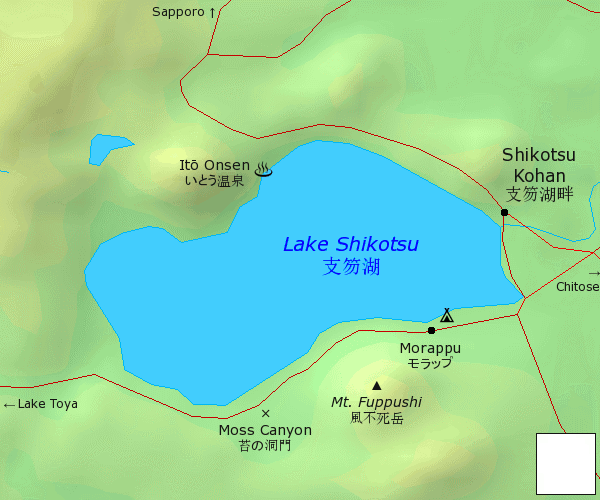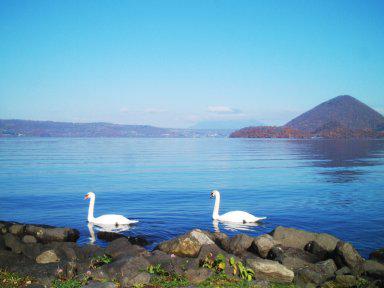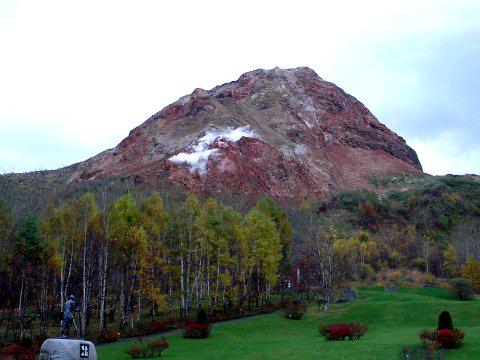Shikotsu-Tōya National Park (支笏洞爺国立公園 Shikotsu-tōya-kokuritsukōen) is a national park (983 km²) in the central part of the island of Hokkaido, Japan. There are many lakes and active volcanoes in the park. Showa-Shin-zan, Usa-zan, and Tarumae-zan are the more well known among the active volcanoes. These volcanoes are also responsible for some popular onsens.
 Surrounded by hills, the dominant feature is Mount Fuppushidake (風不死岳), an Ainu name cleverly written in kanji as "Wind-never-dies Peak". The main town is
Surrounded by hills, the dominant feature is Mount Fuppushidake (風不死岳), an Ainu name cleverly written in kanji as "Wind-never-dies Peak". The main town is
- Shikotsu Kohan. A small village on the eastern side of the lake. There is a small tourist information office here, near the bus station.
- Toyako Onse. A small hot spring town on the shore of Lake Toya, There is an excellent visitor center about 100 m from the bus station. All sorts of interesting information can be found there regarding the history of the area and explanation of volcanic activity, etc. There is also a separate volcano exhibition in the center which costs ¥600 to enter.
Shikotsu Kohan. A small village on the eastern side of the lake. There is a small tourist information office here, near the bus station.
Toyako Onse. A small hot spring town on the shore of Lake Toya, There is an excellent visitor center about 100 m from the bus station. All sorts of interesting information can be found there regarding the history of the area and explanation of volcanic activity, etc. There is also a separate volcano exhibition in the center which costs ¥600 to enter.
No fees required. Permits not generally required.

- Lake Shikotsu. A caldera lake surrounded by active volcanoes and an unreal mossy gorge, 44 km in diameter, Lake Shikotsu is famed for the clarity of its water.
- Lake Toya. Right next to Mt. Usu, one of Japan's most active volcanoes; you can see what happened to buildings, cars, roads, etc., when a volcano erupts. A near-circular lake 10 km in diameter, Lake Toya is famed for the clarity of its water, and it never freezes in winter thanks to the geothermal activity of the region. Along with nearby Lake Shikotsu, it forms a part of the Shikotsu-Toya National Park. This is a caldera lake, the remains of a very large volcanic eruption that has hollowed out ground, where the water is highly mineral rich.
- Moss Canyon. On the south side of the lake, these are in fact two canyons, both several hundred meters long, densely carpeted with thick, green moss. Free entry and well worth a visit.
- Mt. Usu. This 737-m peak is the most active of the lot, with 4 major eruptions in the last 100 years. The latest in 2000 showered much of the neighboring town of Toyako Onsen with ash and debris. The mountain has quieted down now, and there are trails leading to newly created craters on the west side of the mountain. The most notable is Nishiyama Crater Trail (西山火口散策路), where you can see what happens to buildings, cars, roads, etc when a volcano erupts. It is also possible to hike around the southern half of the main crater if one takes the cable car on the east side to the rim. You can see a former public hot bathing house half-inundated with mud, a block of public housing whose first floor is completely buried on one side, and a part of a former bridge which was pushed by the mud some 300 metres from its original position. Just as you start this walk, there is a small hut with a man inside giving away maps of hiking in the Toyoko region in various languages including English. For some reason, the Visitor's Centre does not have this extremely useful brochure.

- Shōwashinzan. This mountain, literally "Showa New Mountain", popped out in a local farmer's field in December 1943 and, two years later, had reached a height of 402 m. It is located right next to the cable car valley station on the east side of Mt. Usu.
Lake Shikotsu. A caldera lake surrounded by active volcanoes and an unreal mossy gorge, 44 km in diameter, Lake Shikotsu is famed for the clarity of its water.
Lake Toya. Right next to Mt. Usu, one of Japan's most active volcanoes; you can see what happened to buildings, cars, roads, etc., when a volcano erupts. A near-circular lake 10 km in diameter, Lake Toya is famed for the clarity of its water, and it never freezes in winter thanks to the geothermal activity of the region. Along with nearby [[Lake Shikotsu]], it forms a part of the [[Shikotsu-Toya National Park]]. This is a caldera lake, the remains of a very large volcanic eruption that has hollowed out ground, where the water is highly mineral rich.
Moss Canyon. On the south side of the lake, these are in fact two canyons, both several hundred meters long, densely carpeted with thick, green moss. Free entry and well worth a visit.
Mt. Usu. This 737-m peak is the most active of the lot, with 4 major eruptions in the last 100 years. The latest in 2000 showered much of the neighboring town of Toyako Onsen with ash and debris. The mountain has quieted down now, and there are trails leading to newly created craters on the west side of the mountain. The most notable is Nishiyama Crater Trail (西山火口散策路), where you can see what happens to buildings, cars, roads, etc when a volcano erupts. It is also possible to hike around the southern half of the main crater if one takes the cable car on the east side to the rim. You can see a former public hot bathing house half-inundated with mud, a block of public housing whose first floor is completely buried on one side, and a part of a former bridge which was pushed by the mud some 300 metres from its original position. Just as you start this walk, there is a small hut with a man inside giving away maps of hiking in the Toyoko region in various languages including English. For some reason, the Visitor's Centre does not have this extremely useful brochure.
Shōwashinzan. This mountain, literally "Showa New Mountain", popped out in a local farmer's field in December 1943 and, two years later, had reached a height of 402 m. It is located right next to the cable car valley station on the east side of Mt. Usu.
- In season, you can rent swan boats for paddling out on the lake Shikotse, there are also boats for rent on lake Toya.
- Fishing is popular.
Being a volcanic lake, there are a number of hot springs in the vicinity. Both hot springs below also offer lodging. Noboribetsu is here, and is one of most famous hot spring resort on Hokkaido, and Toyako Onsen is, as the name suggests, also packed with Onsens.
- Itō Onsen, +81 123 25-2620. 10AM-4PM. On the northern side of the lake, 3 km west from the main road towards Sapporo. Notably primarily for a pleasant outdoor rotenburo with great views of the lake; it's a little strange to stand by the lakeshore completely naked, but hey, you're just a flyspeck if seen from the other side. ¥700.
- Kyūkamura Shikotsu Onsen. A somewhat clinical hot spring resort not far from Shikotsu Kohan. ¥700.
- Hot Spring Hotel Marukoma, Shikotsuko Poropinai 7, Chitose (A few kilometers SW of Itō Onsen, at the end of the side road., +81 123 25-2341. This is a lakeside hotel and onsen. There are indoor and outdoor baths, and also saunas. Bath ¥1000.
Itō Onsen, +81 123 25-2620. 10AM-4PM. On the northern side of the lake, 3 km west from the main road towards Sapporo. Notably primarily for a pleasant outdoor rotenburo with great views of the lake; it's a little strange to stand by the lakeshore completely naked, but hey, you're just a flyspeck if seen from the other side. ¥700.
Kyūkamura Shikotsu Onsen. A somewhat clinical hot spring resort not far from Shikotsu Kohan. ¥700.
Hot Spring Hotel Marukoma, Shikotsuko Poropinai 7, Chitose (A few kilometers SW of Itō Onsen, at the end of the side road., +81 123 25-2341. This is a lakeside hotel and onsen. There are indoor and outdoor baths, and also saunas. Bath ¥1000.
In season, you can rent swan boats for paddling out on the lake Shikotse, there are also boats for rent on lake Toya.
Fishing is popular.
Shikotsu Kohan and Toyako Onsen has the usual array of Japanese restaurants. There are some basic stalls near the Morappu Camping grounds as well.
You're in bear country. Don't feed the bears. Make noise and they'll avoid you if possible, they are usually more afraid of you.
